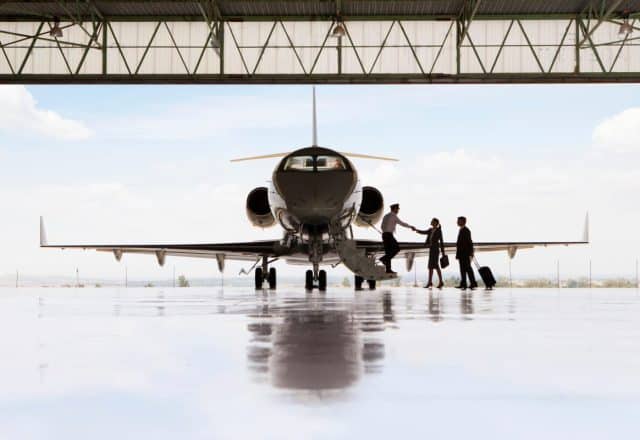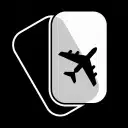What You Need to Know About Part 135
As with any government classification, Federal Aviation Regulations Part 135 can be complex and tricky to understand. But the basics of it is that it allows private planes the ability to earn income by operating charter flights on-demand and with unscheduled air service.
A Part 135 certificate is the legal authority of the company to operate the aircraft. While a plane doesn’t require a Part 135 certificate, it does need to be added to the Part 135 air carrier D-085. This is an FAA listing that designates that the aircraft is qualified to be operated by the company for hire, and can legally be used for private jet charter services.
There are intricacies, and other related certificates, including the Part 91 and Part 121, that aircraft owners should be aware of. Both of these regulate specific instances that are similar to Part 135. Better understanding the details can help you become a better equipped aircraft owner and utilize your asset to its fullest potential.
So why is it important to know about Part 135? It’s the permission slip that all private air carriers need to fly for hire. Below, we highlight the basics of Part 135 with a regulations cheat sheet, plus the details you need to know to understand the differences between Part 135, Part 91, and Part 121.
What Are the Basics of Part 135?
At its core, FAA Part 135 is a certificate required by the Federal Aviation Administration for a company to operate as a non-scheduled air charter carrier. It’s designed to set boundaries and establish safety procedures for jet charters and other types of commercial aviation operations that fly on demand.
Part 135’s requirements are for operators, pilots, and the specific aircraft used during operation. With Part 135 certification, operators are required to follow rules and regulations to operate the aircraft legally. Operators who neglect to follow Part 135 requirements are subject to certification removal. With Part 135, pilots and aircraft owners are given a strong set of rules that include:
- Certification requirements
- Needs for aircraft maintenance and inspections
- Operational procedures and safety requirements
- Minimum equipment requirements
- Insurance requirements for operators
Certification requirements
To be considered for Part 135 certification, owners and operators are required to display:
- Company ownership and proof of U.S. citizenship: “If the proposed certificate holder will be owned by a partnership, each member of the partnership must be a U S citizen, if owned by a corporation or association created or organized under the laws of the United States or of any State, Territory, or possession of the United States, the president and two-thirds or more of the board of directors and other managing officers thereof must be a citizen of the United States and at least 75 percent of the voting interest must be owned or controlled by persons who are citizens of the United States or of one of its possessions.”
- Principal base of ownership. There must be documentation of ownership or a lease agreement that displays an established physical location as the principal base of operation.
- At least one aircraft that meets baseline requirements. The applicant must have at least one aircraft that meets Part 135 rules and regulations to earn a certificate. A written statement must be presented that shows that the aircraft and its equipment conforms to the requirements of 14 CFR 135.25. Documentation like registration, current airworthiness certification, identification, and current airworthy condition must be presented at this time.
Needs for aircraft maintenance and inspections
Aircraft management and inspection needs are dependent on the size of the aircraft and scope of the operation. The FAA details that aircraft that include 10 seats or more should be maintained under a maintenance program that requires operators to maintain and report service difficulty, mechanical interruption, overall maintenance, preventive maintenance, and alteration organization, and airworthiness release or aircraft maintenance log entry. Further details can be found in 135.415, 135.417, 135.423, and 135.443 of Part 135.
Maintenance records are required to be complete without any gaps in the documentation. Neglecting to do so will put your aircraft at a zero time status for Time Between Overhauls. An Advisory Circular conducts conformity checks on every aircraft to ensure these requirements are met.
Operational procedures and safety requirements
This includes rules for flight planning, crew rest, and weather minimums. The certificate holder is required to provide each flight crewmember at least 13 different rest periods within a consecutive 24-hour period in each calendar quarter. According to the Code of Federal Regulations Crew Rest requirements are limited to a 14 hour duty day.
(1) At least 10 consecutive hours of rest immediately preceding the assignment;
(2) No more than 8 hours of flight deck duty in any 24 consecutive hours; 10 hours for a flight crew consisting of two pilots qualified under this part for the operation being conducted.
Visibility requirements regarding weather conditions also apply under Part 135. The Visual Flight Rules for visibility for aircraft says “No person may operate an airplane under VFR in uncontrolled airspace when the ceiling is less than 1,000 feet unless flight visibility is at least 2 miles.”

Minimum equipment requirements
A Minimum Equipment List (MEL) is a list specific to the requirements for equipment for the operation of an aircraft. According to the National Business Aviation Association, a MEL is an evolution of the Master Minimum Equipment List created by the original equipment manufacturer of the aircraft in question. In other words, the MEL is a smaller, itemized list created by the operator of the aircraft. It’s important because it’s an FAA approved document that allows the owner and/or operator of the aircraft to fly with certain items inoperative.
“The MMEL includes all equipment and accessories available for the aircraft model, while the MEL is created by the operator for your specific type of aircraft,” Elaine Karabatsos, aviation maintenance director shared with the NBAA. “If you’re flying serial number 15, you’re going to customize your MEL for the equipment on your aircraft that may not be present on serial number seven.”
With an updated MEL, operators are equipped to comply with all safety rules and regulations regarding the aircraft equipment.
Insurance requirement for operators
Under Part 135, operators are required to maintain and showcase minimum insurance coverage.
As explained by The Legal Information Institute, U.S. and foreign direct air carriers need to have:
“Third-party aircraft accident liability coverage for bodily injury to or death of persons, including nonemployee cargo attendants, other than passengers, and for damage to property, with minimum limits of $300,000 for any one person in any one occurrence, and a total of $20,000,000 per involved aircraft for each occurrence, except that for aircraft of not more than 60 seats or 18,000 pounds maximum payload capacity, carriers need only maintain coverage of $2,000,000 per involved aircraft for each occurrence.”
Additional coverage is needed for operators with additional passengers. U.S air taxi operators are required additional coverage under Part 298. Stratos’ increased minimums include:
- Liability insurance: At least $25 million for turbo-props and $50 million for all other aircraft types.
- Certificate of insurance: Add Stratos Jets to your COI with a waiver of subrogation provided for the tail number assigned.
- Stratos also carries a $10 Million non-owned aircraft liability policy that goes over and above the air carriers policy.
What Are the Differences Between Part 135, Part 91, and Part 121?
Part 91 and Part 121 are two other sets of regulations issued by the FAA. While Part 135 covers operations of aircraft that can legally be operated for private jet charter, Part 91 is made up of loose rules and does not permit commercial activity. Part 121 is a designation that covers large commercial carriers as well as scheduled airlines.
To better understand the main differences between these and Part 135, we’ve highlighted some of the key concepts of all three regulations.
- Part 135 is for aircraft like private jet charter service or air taxi. The training requirements for Part 135 are less strict than Part 121 but more detailed than Part 91. These regulations are focused on unscheduled air transportation.
- Part 91 covers private, corporate, and business flights, governing the type of operations and who can fly. There’s no requirement for an operator’s certificate from the FAA, and it doesn’t require the same level of aircraft maintenance, safety procedures, pilot qualifications and training as Part 135 and Part 121. These regulations don’t permit commercial flight activity, so owners can’t accept compensation for a flight.
- Part 121 covers scheduled airlines and other large commercial carriers and requires extensive training that goes beyond that required for Part 91 and Part 135. Flight planning and scheduling requirements are also more strict.
FAR 135 FAQs
How Have Regulations Like FAR 135 Made Aviation Safer?
With FAR 135, Part 91 and countless other regulations in place, aviation safety has come a long way since the Wright brothers made their 12-second flight in 1903.
Within a few years of that historic flight, modern aircraft started to appear across the globe. The First World War brought significant technological advancements, but flying remained a dangerous game.
Commercial aviation didn’t take root until 1925 with the Air Mail Act. Fast-forward a few years, and domestic travel by airplane truly takes off with the birth of four major airlines, two of which—United and American—are still in operation today.
However, it would take more than two decades, countless fatal crashes and the tragic collision of two airplanes above the Grand Canyon before a federal agency stepped in to make air travel safer for all.
Today, under the umbrella of the Department of Transportation, the Federal Aviation Administration (FAA) regulates every aspect of commercial and private flight in the United States. Only military aircraft are outside the jurisdiction of the FAA.
Thanks to the stringent policies implemented by the FAA, flying is the safest way to travel in America.
How Many Hours Do You Need to Fly Part 135?
Pilots operating a Part 135 aircraft need to have at least 500 total flight hours, 100 hours of cross-country time and 25 hours at night.
At Stratos, we hold our pilots to a higher standard. Before a pilot can serve as the pilot-in-command for one of our clients, they must have:
- A minimum of 3,000 hours of total flight time, with half as the pilot in command
- A first-class medical certificate
- At least 250 hours ‘time in type’ training for the specific aircraft they’re flying
However, hours are only one piece of Part 135 pilot requirements. Some of these regulations include:
- FAR 135.293, which mandates initial and ongoing pilot testing requirements. To fly a Part 135-certified aircraft, pilots must have passed a written or oral test on part regulations, aircraft types, navigation, air traffic control procedures and meteorology within the last 12 months.
- FAR 135.243 highlights the qualifications that must be met for the pilot-in-command. These qualifications include holding an airline transport pilot certificate for aircraft with 10 or more seats, appropriate category and class ratings for the aircraft, and the hour requirements discussed earlier.
- FAR 135.297, notes the proficiency check requirements for instrument flight rules (IFR). At a high level, these requirements dictate that the pilot must have recently passed an instrument proficiency check before being allowed to fly Part 135 aircraft.
What Is the Difference Between Part 125 and 135?
Any aircraft that can seat 20 or more people or has a maximum payload capacity of 6,000 lbs. or more is subject to Part 125 restrictions. Large commercial passenger planes such as the 120-seat Boeing 737 and 266-seat Airbus A300-600R fall into this category.
Under Part 125, owners can use these large airliners without having to obtain the expensive Part 121 certificate, which is required for commercial airlines. However, Part 125 becomes more complicated when it comes to carrying other passengers.
Under Part 125, these large aircraft are prohibited from common carriage. According to the FAA, “A person is considered to be engaged in common carriage when holding out to the general public or to a segment of the public as willing to furnish transportation within the limits of its facilities to any person who wants it.” Any form of advertising, whether it’s on social media or a billboard, constitutes holding out.
Essentially, this means that Part 125 is meant for the private use of large aircraft. They may, however, be used by a sports team, for example, if the aircraft is at least partially owned by the team. The DOT tests compliance by determining “whether the carriage by air is merely incidental to the person’s other business or is, in itself, a major enterprise for profit.”
What Is the Difference Between FAR 135 and FAR 91?
Where Part 135 governs aircraft used for charter, FAR 91, or Part 91 operations, are for non-commercial flights. A private aircraft owner who doesn’t use their aircraft for charter, for example, only needs a Part 91 certificate.
Like Part 135, Part 91 certificates regulate pilot, weather and runway landing requirements. Though, as they are considered non-commercial, Part 91 gives owners and operators more freedom and flexibility.
Any form of payment—whether it’s money, a gift or compensation for the costs incurred while flying—is considered commercial and therefore subject to Part 135. Operators or owners found to be operating commercial flights under a Part 91 certificate face serious fines, having their aircraft impounded and even risk jail time.
When you book a charter flight, be sure to confirm the certificate with your flight advisor. At Stratos, we only fly with Part 135 operators and ensure that the aircraft, crew and maintenance meet our rigorous safety standards.
Ready to Book Your Best Charter Flight Yet?
Stratos Jet Charters requires all charter operators within its network to undergo certification with independent auditing companies such as ARGUS and Wyvern. We do this to ensure that our clients are only flying on aircraft that are properly certified and meet quality safety standards that are well above the minimum standards defined by Part 135.
Looking for more information? Our jet charter agents are available 24/7 to provide you with multiple private jet quotes for your on-demand air charter flight. Book your private jet charter today.
Are you ready to book your Geneva to London charter flight yet?
Our friendly, expert air charter agents are here to answer questions or start your quote today. Don`t wait, call now and we'll get you on your way to your destination!
Call 888-593-9066











